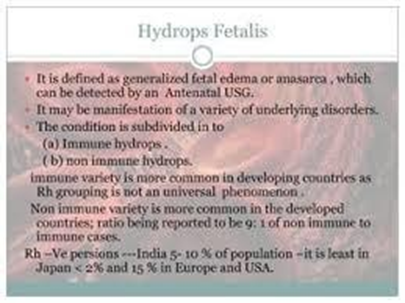A nurse is reinforcing teaching about Rho(D) immunoglobulin to a client who is pregnant. Which of the following findings can an Rh incompatibility cause?
Transient clotting difficulties
Congenital hypothermia
Hypobilirubinemia
Hydrops fetalis
The Correct Answer is D
A. Rh incompatibility primarily affects erythrocytes, resulting in hemolysis rather than clotting abnormalities. Therefore, transient clotting difficulties are not typically associated with this condition.
B. Rh incompatibility doesn't directly cause hypothermia in newborns. The condition primarily leads to hemolytic disease of the newborn, which can result in jaundice, anemia, and other complications, but not hypothermia.
C. Rh incompatibility leads to an increase in bilirubin levels, causing hyperbilirubinemia rather than hypobilirubinemia. This increase in bilirubin levels can lead to jaundice and potentially severe neurological complications in the newborn.
D. This is a severe complication of Rh incompatibility where the fetus experiences severe edema due to hemolytic anemia and heart failure. It results from the destruction of fetal red blood cells by maternal antibodies against Rh-positive blood cells.

Nursing Test Bank
Naxlex Comprehensive Predictor Exams
Related Questions
Correct Answer is A
Explanation
A. Levodopa/carbidopa is often prescribed to manage Parkinson's disease symptoms. Taking it with applesauce, or other light, easily digestible foods, can help reduce nausea, a common side effect of the medication.
B. While yogurt is generally well-tolerated, it may not be as effective in reducing nausea as applesauce.
C. Cheese is not typically recommended to take with levodopa/carbidopa for nausea relief.
D. Spinach is not commonly used to alleviate nausea associated with levodopa/carbidopa intake.
Correct Answer is C
Explanation
A. Alprazolam, a benzodiazepine, typically doesn't cause hypertension. Its primary mechanism of action involves modulation of GABA receptors in the central nervous system, leading to anxiolytic effects rather than effects on blood pressure regulation.
B. There's no documented association between alprazolam use and hearing loss.
Benzodiazepines like alprazolam primarily affect the central nervous system and do not target auditory structures.
C. Sedation is a common side effect of alprazolam due to its CNS depressant properties.
Patients often experience drowsiness, fatigue, and impaired cognitive function, especially when initiating therapy or when doses are increased.
D. Alprazolam typically doesn't cause bradycardia. While it can have mild effects on heart rate, such as tachycardia, significant bradycardia is not a documented adverse effect.
Whether you are a student looking to ace your exams or a practicing nurse seeking to enhance your expertise , our nursing education contents will empower you with the confidence and competence to make a difference in the lives of patients and become a respected leader in the healthcare field.
Visit Naxlex, invest in your future and unlock endless possibilities with our unparalleled nursing education contents today
Report Wrong Answer on the Current Question
Do you disagree with the answer? If yes, what is your expected answer? Explain.
Kindly be descriptive with the issue you are facing.
